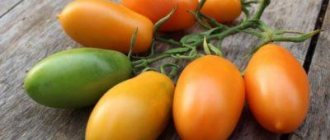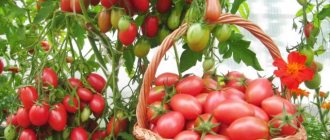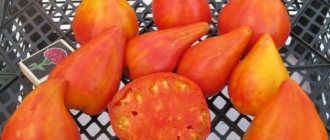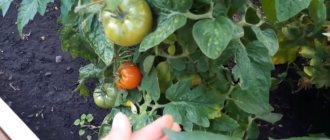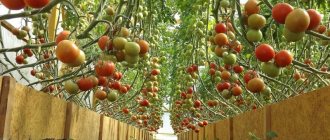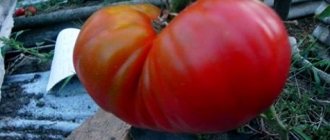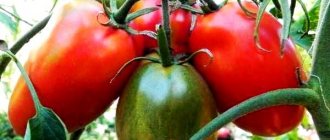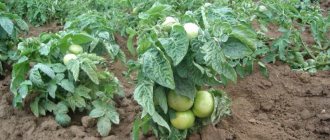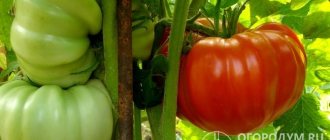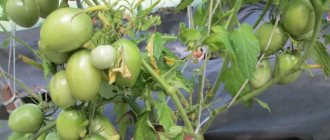Description of the variety
In its homeland, Kuban, this tomato grows in open ground. In midland conditions, it is recommended to grow this powerful indet in a greenhouse. This is also due to the timing of ripening, since the Kolovy variety is a mid-season tomato, and in regions with a short summer on the ridges the fruits may not have time to form.
The beautiful Kolovoy bush reaches a height of approximately 170-180 cm, and can reach up to 200 cm. The plant is powerful, with spreading branches, so no more than three bushes are planted per square meter. The foliage is high, and this is also the reason for strict adherence to the planting scheme.
You can pick the fruits after about 110-115 days, but they will not be quite ripe (green), in a state of technical ripeness. It will take about another week and a half until full ripening.
Tomato variety Doll, description, characteristics and reviews, as well as cultivation features
The Krasnodar region is one of the leaders in our country in the production of tomatoes.
The Krasnodar region cultivates a variety of tomato varieties, but when choosing planting material, it is necessary to focus on the characteristics of the soil and the climatic conditions of a particular area. Krasnodar region is one of the leaders in our country in the production of tomatoes
The Krasnodar Territory is heterogeneous in its climatic conditions: the northern (plain) part, occupying about 70% of the territory, is characterized by frequent droughts, and humid subtropics are located in the south and in the foothills.
And if the subtropical climate is natural for growing tomatoes, then the hot and arid environment of the plain of the Krasnodar Territory requires careful selection of tomato varieties that are resistant to drought, with abundant foliage that can protect the fruits from the scorching sun.
When choosing a tomato variety, they are guided by the following criteria:
- compliance with soil and climate characteristics, as well as resistance to diseases;
- productivity (hybrid varieties give higher yields compared to pure collection varieties);
- ripening terms (early, mid-ripening, mid-late or late);
- purpose of the crop (for salads, canning or long-term storage).
Early varieties
In the climatic conditions of the Krasnodar Territory, early and mid-ripening varieties of tomatoes are recommended to be grown in open ground. Tomato seeds are initially sown in local containers for subsequent transplantation into open ground. Often, eggshells are used to produce seedlings, which subsequently serve as a natural fertilizer for the plant.
Popular early varieties of tomatoes:
- Mystery. It is characterized by a very early period of fruit ripening - from 85 to 100 days. Small tomatoes weighing 80-100 g, bright red in color and round in shape. The height of the bush is small (up to 0.5 m). The fruits have a characteristic sour aftertaste.
- Chinese variety. A low plant (up to 0.55 m) with a ripening period of 95 to 100 days. The tomatoes are slightly flattened, red in color, small in size (70-200 g) and have excellent taste. It gives good yield and is versatile in application.
- Anastasia. This variety gives a high yield: from 1 bush you can harvest up to 13 kg of tomatoes, formed on clusters of 5-7 pieces. The shape is elongated, the color is bright red, the weight of the fruit is up to 200 g. Since fruiting is abundant, the plant must be tied to a trellis or other structure at least every 20 cm.
- Persimmon variety. It belongs to the mid-early hybrids (105-115 days), with a plant height of up to 1 m. It received its name for its visual resemblance to persimmons: the fruits are bright orange, quite large and have a pleasant sweet taste. The yield reaches 5 kg from 1 bush, the application is universal.
- Salute (Fireworks). The ripening period is 110-120 days (medium early). Suitable for outdoor cultivation. The mass of the fruit is small (up to 50 g), red in color, with fleshy pulp and a shape reminiscent of a plum. It tolerates transportation very well and, due to its high yield, is suitable for cultivation on an industrial scale. Preferred use is preservation.
- Crimson giant. The ripening speed is from 105 to 110 days, the height of the bush is up to 1 m. The fruits are from medium size to very large (500 g), crimson in color, and not always of the correct shape. A very good variety for salads and fresh use. It is resistant to diseases.
- Tarasenko Yubileiny. A tall plant (up to 1.8 m) with a powerful stem and an average number of large leaves. Fruits weighing 100-200 g are formed in large clusters (15-25 pieces) and ripen in a period of 115 to 120 days. With good care, it produces a yield of up to 15 kg per bush.
In the Krasnodar Territory, tomatoes are grown in all possible ways: in open ground, in greenhouses and under film.
Tomato Doll was created to please busy gardeners who want to get a good harvest with minimal effort. On a low bush there grow many tomatoes that are almost identical in shape and size, and large ones at that. The undeniable advantage of the hybrid is its high yield at early ripening. And they argue about the taste of its fruits, contrary to the saying.
The Kukla tomato appeared in the State Register of Breeding Achievements in 2006, but it began to be grown in gardens earlier. There are reviews about this hybrid left in 2004. The originator of the variety is.
We invite you to familiarize yourself with: Selection of the best tomato varieties for the northwestern region
Interestingly, Doll F1 began a series of tomatoes with a similar name. So, in 2010, Doll Masha was registered, and a year later - Doll Dasha.
All of them grow as low bushes, produce large pink tomatoes, but differ in ripening time, purpose, weight and taste of the fruit.
The Kukla tomato was bred for cultivation in open ground and zoned for the Volga-Vyatka region. This is where the hybrid will be most productive. However, zoning for other climatic zones has never stopped the Russians. Tomato seeds Doll F1 are sold throughout the country, tomatoes are grown and vegetable growers from all over the Russian Federation and neighboring countries share their impressions.
Description of the hybrid
The doll is a determinate tomato, that is, the stem has limited growth, crowned with a brush with flowers, is crowned and has no continuation. Further development comes at the expense of the stepchildren. The height of the bush is 50–80 cm, depending on the quality of summer and the place of cultivation. Although the hybrid was created for open ground, its seedlings are also planted in greenhouses. There the bushes grow taller, more powerful and more productive.
The Doll’s bush is low and compact
The first fruits ripen in 85–95 days. Unripe tomatoes have a characteristic dark green spot at the stalk; when ripe, they turn bright pink, almost red. Each weight is 71–190 g.
The originator claims more impressive figures - 150-200 g, and with good care - 400 g! Several fruits can ripen simultaneously on one bush. All of them are approximately the same in size, the yield of marketable products reaches 100%! This means: all have a beautiful appearance, suitable for sale. The State Register writes modestly about taste: “good.”
The productivity of Kukla F1 tomatoes is 263–632 c/ha. According to this indicator, the hybrid exceeds the standard for the category of early and determinate varieties Sibirsky early ripening and Belyi naliv by 27–162 c/ha. On a personal plot, the yield per square meter is 8 kg.
Experienced summer residents can boast of a successful harvest in the fall and winter, because they know exactly how to select varieties and seeds of vegetables for planting themselves.
As a rule, only the best varieties of tomatoes, cucumbers, radishes and other vegetables grow on their plot. The first type of vegetable deserves special attention, which not only has a slightly sweet taste, but also does not require painstaking cultivation.
Moreover, according to the same experienced summer residents, the rapid rooting of seedlings after planting and the harvest are influenced not only by proper cultivation, but also by the correctly selected variety. This fact leads to the need to analyze the best varieties of tomatoes.
There is a similar article on this topic - Growing tomatoes in a greenhouse and open ground.
Breeders divide all varieties of tomatoes into two categories, which include:
- Determinate varieties are varieties that grow in a somewhat limited manner. So, a tomato bush grows to a certain brush and stops growing altogether. The result is a low-growing bush, but excellent for planting in a greenhouse.
- Indeterminate varieties - grow as long as the weather is favorable with its temperature indicators. They are grown in most cases in a greenhouse or in the center of a large greenhouse. These varieties are more resistant to weather conditions and therefore make up a larger proportion of the tomatoes planted.
Surprisingly, among the indeterminate varieties, the most popular and sought-after seeds are “Budenovka”. This variety is good for all its main characteristics: up to one and a half meters high, the first harvest 100 days after seed germination, the ability to grow both in a greenhouse and in open ground.
This variety also does not require any additional care and is perfect for beginner gardeners. From one bush you can harvest at least 4-5 kg, and if you create favorable climatic conditions - all 7 kg.
Fruit characteristics
This variety is known for its amazing-tasting and beautiful-looking tomatoes. By weight - up to 250-400 grams, while some tomatoes may be larger. The shape is heart-shaped, regular and symmetrical.
The fruits have a thin but rather dense skin and are not prone to cracking. The pulp is unusually aromatic and sweet, there are very few seeds. The chambers of the fruit are located at the edges, most of the insides are occupied by juicy pulp.
The best use of such tomatoes is in salads, but they are also suitable for processing into sauces, pasta, and juice.
One large sweet tomato of the Kolovy variety is quite enough for one salad, but for preservation it is recommended to choose other tomatoes.
Tomato variety Kolovy: advantages and disadvantages
The Kolovy variety has been grown by more than one generation of gardeners, and without exaggeration we can say that everyone likes it.
Advantages:
- large fruits;
- excellent taste;
- disease resistance;
- long-term fruiting subject to the rules of agricultural technology;
- very high yield (up to 10 kg per bush).
The seeds of the variety are not sold in stores; they can usually be purchased from gardeners or amateur tomato collectors. Kolovy, in its essence, is a variety of folk selection that has spread quite widely across many regions of the country. On the plus side, we note that you can collect your own seeds from tomatoes.
At the same time, it should be noted that this is a variety of southern tomato that bears fruit well in the long summer season. In the middle zone, you can get a harvest from it only by cultivating it in greenhouses.
The Kolovy variety requires mandatory plant formation and pinching. Supports are needed, and not only the stems, but also each cluster with large fruits requires garters.
Choosing tomatoes for the Krasnodar region
Tomato varieties for the warm climate of the Krasnodar region. Hybrids with different ripening periods: mid-early, late-early, early ripening. Tomato varieties for growing in greenhouses in Krasnodar.
The soil and climatic conditions of the southern regions determined the susceptibility to the cultivation of certain categories of vegetable crops. Among them, the tomato is especially successfully cultivated. The specifics of choosing a variety are individual and depend on the shape, taste, color, as well as the unpretentiousness of the tomato.
We invite you to familiarize yourself with: The best varieties of coffee beans in the world.
When wondering which tomato variety is preferable for the Krasnodar region, you can come across more than one answer. With the right approach and appropriate area, more than 30-40 plant species can be cultivated annually.
The main criteria for choosing a variety are:
- “Immunity” to diseases (endurance/resistance).
- Yield indicators.
- Priority guides: collection or hybrid varieties.
- Tomato ripening cycle (early/late).
- Fruit size: large, small, etc.
It is recommended to cultivate early categories of tomatoes on exhaust gas. Such plants are first sown in special containers and later transplanted into the soil. Another recognized method is to grow shoots in egg shells, which serve as fertilizer when planted in the ground.
The “Riddle” tomato variety is characterized by strong and dense stems, on the clusters of which 5-6 sour tomatoes are formed. The fruits belong to the ultra-early period of ripening. Features of the vegetable:
- bright red round tomatoes weighing 80-100 g;
- ripening period: 85 – 100 days;
- height it reaches: up to 50 cm (up to the knee);
- belongs to the superdeterminant class (there is practically no need to stepchild);
- endurance: complex (late blight, septoria, black leg, etc.).
Chinese
“Chinese” is an early-ripening variety of tomatoes, which is characterized by a high degree of fertility. The bushes need moderate pinching. Characteristics of the vegetable:
- red flat-round tomatoes weighing 70-110 g;
- height it reaches: 45-55 cm;
- positive taste qualities;
- unpretentious and hardy;
- belongs to the determinant class.
The fruits have universal uses: for canning, salads, etc.
Anastasia
“Anastasia” belongs to the early-ripening categories of tomatoes, which often have a green spot on the stalk. Plant characteristics:
- medium-dense elliptical tomatoes weighing 130-180 g;
- quality of taste – positive;
- red tomatoes;
- the brush forms 6-7 tomatoes;
- yield: about 12 kg per bush;
- group: determinant;
- the stem needs gartering and shaping.
The tomato variety is characterized by a weakly branched but strongly leafy stem. The tomato resembles a persimmon in shape and color and has an excellent taste. Features of the vegetable:
- bright orange sweet tomatoes weighing 150-200 g;
- height it reaches: 70-100 cm;
- ripening period: from 107 to 115 days;
- type: universal;
- yield: about 5 kg per bush;
- belongs to the determinant group.
"Persimmon" needs regular pinching.
Salute or fireworks
“Salute” is a mid-early category of tomatoes, which is characterized by decorative features. The brush can simultaneously contain both ripe tomatoes and flowers and ovaries. Characteristics of “Fireworks”:
- bright yellow plum tomatoes weighing 15-20 g;
- the height that the bush reaches is up to 80 cm;
- ripening period: 126-130 days;
- yield: 308-755 c/ha;
- belongs to the determinant class;
- endurance: VTM.
The fruits are preferably used for preservation.
Crimson Giant
“Crimson Giant” belongs to the large varieties of determinate tomatoes. Features of the vegetable:
- unequal raspberry tomatoes weighing 500-700 g;
- type: salad;
- yield: about 11 kg per bush;
- ripening speed: from 105 to 110 days;
- pinching: moderate;
- rarely gets sick.
"Hybrid-35" is a mid-season tomato variety. Cultivation is recommended in protected soil and requires timely rooting. Characteristics of the vegetable:
- red round tomatoes weighing 100-200 g;
- the brush forms 15-20 fruits;
- ripening speed: 115-120 days;
- type: for preservation;
- height it reaches: up to 1.8 m;
- belongs to the indeterminate class.
“Jubilee Tarasenko” does not have special endurance (immunity) to diseases.
Late and mid-season tomatoes mainly bear fruit from July to August. Plants are cultivated without seedlings or seedlings.
The variety is determined for the late ripening period of cultivation. The tomato is shaped and colored like a lemon. Features of the “miracle”:
- yellow round tomatoes weighing 60-100 g;
- ripening period: 120-125 days;
- up to 2 m – height of the bush;
- type: for preservation, pickling;
- belongs to the indeterminate group and requires garter;
- highly resistant to diseases.
Digitomandra
A mid-season tomato variety that can withstand cold temperatures down to -5. Define Inka Gold (with apricot flavor), Solid Gold (for soup or puree) and Rotamer (sweet taste). Features of the vegetable:
- yellow/red round tomatoes weighing 200-300 g;
- height it reaches: up to 2 m;
- the root system and stem are powerful;
- yield: from 6 to 8 kg per bush;
- type: universal (for salads, juices, canning);
- belongs to the indeterminate class;
- highly resistant to diseases.
The "Tsifomandra" bush can be placed indoors for the winter, but in the presence of good lighting.
Doo-karao
“Du-karao” is one of the most common varieties of tomatoes for canning. The diversity of species led to different colors: red, pink, black, yellow. Plant characteristics:
- height it reaches: up to 3.5 m;
- fruit shape: oval, weighing 70-90 g;
- maintains integrity during heat treatment;
- yield: from 6 to 8 kg per bush;
- the brush forms 9-12 fruits;
- Moderately resistant to diseases.
We invite you to familiarize yourself with: Tomato Big Beef F1: description of the characteristics of the tomato variety with photos
Russian giant
“Russian Giant” belongs to the mid-season categories of tomatoes with positive taste. The tomatoes grow juicy and fleshy. Features of the vegetable:
- large red tomatoes weighing up to 600 g;
- height it reaches: up to 1.8 m;
- yield: from 4 to 6 kg per bush;
- resistant to pests and diseases;
- belongs to the indeterminate class.
The “Russian Giant” variety requires timely pinching.
“Giant of the East” is a mid-late tomato variety that is characterized by increased productivity and bears fruit from July to September. Features of the “giant”:
- pink, sugary, flat-round tomatoes weighing up to 500 g;
- height it reaches: up to 1.8 m;
- type: salad;
- class: indeterminate;
- stepsoning: timely.
brindle
“Tiger” refers to the mid-late category of tomatoes, the fruits of which resemble a tiger color. Tomatoes have a red-raspberry color with yellow stripes. The weight of the fruit is 60-70 g. Features of the vegetable:
- positive taste qualities;
- height it reaches: up to 2.5 m;
- the brush forms 9-15 tomatoes;
- yield: up to 7 kg per bush;
- class: indeterminate;
- They bear fruit from July until the onset of cold weather.
Tiger tomatoes are used mainly for canning.
Alpinog
“Alpinog” is a medium-ripening tomato variety that bears fruit from July to August. The taste of tomatoes is sweet. Features of the plant:
- raspberry flat-round tomatoes weighing up to 400 g;
- height it reaches: up to 1.5 m;
- type: salad;
- require regular stepsoning;
- yield: up to 6 kg per bush.
Golden drop
“Golden Drop” belongs to the categories of tomatoes of the mid-late period. The fruits have thick skin and are suitable for preservation. Features of the vegetable:
- bright yellow, drop/pear-shaped tomatoes weighing 60-70 g;
- height it reaches: up to 2 m;
- type: universal;
- highly resistant to diseases;
- belongs to the indeterminate class.
Productivity is 4.8-5.2 kg/sq.m.
Among the tomatoes that can be cultivated in open soil and in a greenhouse, there are many varieties. Such representatives of vegetable crops have significant resistance to temperature changes and high yield rates.
Giant yellow
"Giant Yellow" is an early tomato variety that bears fruit from July to September and is characterized by a sweet taste. Features of the vegetable:
- bright yellow round/flat-round tomatoes weighing 200-300 g;
- height it reaches: up to 1.5 m;
- type: universal;
- aging cycle: 111-115 days;
- yield: about 4-6 kg per bush.
“Yellow Giant” belongs to the indeterminate class and needs timely stepsoning.
Giant Novikova
“Giant Novikova” is a mid-season tomato variety that belongs to the indeterminate class. Plant no more than two tomatoes per 1 m2 and plant them in a timely manner. Plant characteristics:
- pink flattened tomatoes weighing 1 kg;
- height it reaches: up to 2 m;
- type: salad;
- yield: about 20 kg per bush;
- Moderately resistant to diseases.
Bull's heart
“Bull's heart” belongs to the categories of medium-late tomatoes. Tomatoes have a sweet taste and are characterized by meatiness. Features of the vegetable:
- cone-shaped fruits weighing 350-500 g;
- height it reaches: up to 1.5 m;
- bush: vigorous, spreading;
- type: salad;
- belongs to the indeterminant class;
- Moderately resistant to diseases and pests.
Bull's Heart varieties are characterized by black, pink, yellow, white colors (Brad'sBlackHear, KingLondon, Brown'sYellowGian, WhiteOxheart).
Black Prince
“Black Prince” is a mid-season tomato variety that is characterized by a long fruiting period and a sweet taste. Features of the “prince”:
- dark crimson/crimson flat-round tomatoes weighing 250-300 g;
- height it reaches: 170-180 cm;
- yield: up to 8 kg per bush;
- belongs to the indeterminate group;
- moderately resistant to diseases.
Raspberry lamp
“Raspberry Lamp” belongs to the mid-late category of tomatoes. The station wagon is characterized by unpretentiousness in the cultivation process. Plant characteristics:
- raspberry tomatoes weighing 60-80 g;
- height it reaches: 2-2.5 m;
- ripening period: from 116 to 120 days.
- yield: up to 6 kg per bush;
- maintains integrity during heat treatment;
- resistance: late blight.
The “Raspberry Lamp” variety bears fruit from July until the onset of cold weather.
Long keeper
“Long Keeper” belongs to the late-ripening category of tomatoes, which can be stored at home temperature for a long time. Tomatoes are picked green and ripen for 30-35 days. Features of the vegetable:
- whitish-orange round tomatoes weighing 100-150 g;
- height it reaches: 1-1.5 m;
- the bush bears up to 6 kg of fruit;
- needs regular stepsoning;
- belongs to the determinant class.
Tags: cola, variety, tomato
About the author: admin4ik
« Previous entry
Recommendations for cultivation
In Kuban, tomatoes are grown by sowing seeds directly into the beds. For those gardeners who want to get Kolovy tomatoes in central Russia or in other areas, they must first grow strong and healthy seedlings.
Seedlings: what to consider
The seeds need to be soaked in potassium permanganate (15-20 minutes, no more), then placed in a damp cloth for germination. Very often, collectors, sending tomato seeds, give useful recommendations on preparing tomatoes for sowing. So it’s worth listening to them and following the advice of experienced gardeners.
To stimulate germination and obtain strong seedlings, it is also recommended to soak the seeds in compositions with growth stimulants - Epin, Energen, or in an infusion of ordinary wood ash.
It is very important to prepare high-quality soil for tomatoes, using either purchased nutrient mixtures or preparing it yourself in advance.
Fertilizers are added to the soil: superphosphate (one teaspoon per bucket), wood ash. Be sure to add loosening agents to the soil: calcined river sand, vermiculite, so that the soil does not cake and is loose.
When growing seedlings at home, you must strictly maintain the temperature:
- during germination: +23ºC…+25ºC;
- the first days after the emergence of tomatoes: +18ºC;
- before planting seedlings: +21ºC…+23ºC.
The picking is carried out after Kolovoy has two true leaves. It is advisable to choose large pots for this variety, since the root system must be formed in spacious containers.
Water moderately, strictly monitoring soil moisture levels. Over-watering is very dangerous, as tomatoes may develop blackleg disease, and such seedlings will be unsuitable for further cultivation. If necessary, fertilize with complex fertilizers (nitrophoska is suitable) or special compounds for tomato seedlings.
Planting in greenhouses and further care
In the middle zone, you can start planting tomatoes in shelters after the May holidays. Air and soil temperature indicators are taken into account, and the recommendations of the Lunar calendar for a certain year are taken into account.
The place in the greenhouse must be prepared in advance: the soil is dug up, fertilizers are applied. If tomatoes are grown in this greenhouse every year, then in the fall it is necessary to disinfect the greenhouse itself and the soil in it. Experts also advise removing the top layer of soil and replacing it with a new one. It is effective to use green manure, which is sown in autumn or early spring, to improve soil health.
The planting scheme for the Kolovy variety is 3 bushes per square meter. You can add humus, a little ash or superphosphate to the holes. In order for tomatoes to adapt faster, they are covered with additional covering materials right in the greenhouse. This will protect them from bright sunlight for the first time, as well as from possible drops in temperature.
You can’t water planted tomatoes right away; they take a break of 5-6 days. But it will even be useful to mulch the soil around the plants with sawdust, hay or mown grass. Mulch will provide the necessary soil moisture and eliminate the rapid growth of weeds.
It is also advisable to equip the greenhouse with supports for trellises or stock up on stakes before planting seedlings. As soon as the plants grow, they need to be staked and then regularly tied as they grow.
One of the most important procedures when growing tomatoes is watering. Almost everyone knows that tomatoes love abundant but infrequent watering, but in practice not everyone follows this rule. To avoid problems, it is recommended to equip greenhouses with drip irrigation systems.
Water only with settled and warm water (+23ºC), and the water should not get on the leaves of the plants. At the beginning of the growing season, approximately 3-4 liters of water are poured under each bush, and at the beginning of flowering, the volumes are increased. In this case, it is necessary to take into account the condition of the plants themselves, the microclimate in the greenhouse, and weather conditions. On cloudy, cool days, watering is reduced, on hot days it is increased, but the norms are still observed.
In order for the tomato pulp to be sugary and juicy, the volume of water must be reduced at the height of fruiting. But the watering schedule must be observed, since prolonged “droughts”, as well as excess water, can lead to cracking of the Kolovoy fruits.
A powerful and tall variety needs adequate feeding. This is especially true for tomatoes, which are cultivated in the short summer conditions of the middle zone and require a lot of work to get a harvest.
The first feeding includes organic matter, using poultry droppings or mullein, previously diluted with water. Proportions: 1:20 and 1:10. Tomatoes also respond well to the addition of ash infusion.
ON A NOTE! Mixing ash and mullein is not recommended. It is better to first feed the tomatoes with diluted manure or droppings, and after about a week add ash.
The timing of the first fertilizing is no earlier than 18-20 days after planting the tomatoes. Subsequent applications of fertilizers are every 10 days. Tomatoes need nitrogen more at first; in the second half of the growing season, potassium and phosphorus are added.
If there is excess nitrogen in the soil, plants will actively grow green mass to the detriment of fruits. If such a phenomenon is observed, then it is necessary to reduce watering, spray the plants on the leaves with an extract of superphosphate, and also exclude nitrogen from fertilizing.
The following are used as “natural” fertilizers:
- yeast infusions;
- herbal infusions (nettle, comfrey, dandelion);
- banana peel infusions.
Many gardeners prefer to grow vegetables without chemicals, but in this case the tomatoes must be provided with complete and high-quality nutrition.
Good results are shown by the use of ready-made formulations designed specifically for plants of the nightshade family. Specialized stores offer entire lines of various products, including those with a natural composition of elements.
It is recommended to alternate root feeding with leaf treatment of plants (spraying). This way, tomatoes absorb the nutrition and substances they need much faster, instantly forming high-quality flower clusters and accelerating the ripening of fruits.
A special issue is the formation of tomatoes, without which it is impossible to obtain a high yield. It is preferable to grow the Kolovy variety in a greenhouse in one or two stems, so all other shoots are removed.
Stepchildren are broken out every 5-6 days, preventing them from outgrowing. If you decide to leave two stems, then it is best to take the stepson under the first flower cluster as an additional stem. All leaves that grow below this brush are also removed, gradually exposing the tomato stem. It must be remembered that at one time it is allowed to remove no more than two leaves from one plant.
Kolovoy’s clusters usually do not form; the fruits ripen together. To increase the yield from the bush, it is recommended to pick the fruits in a state of technical ripeness, without waiting for them to fully ripen. Those who have already grown this type of tomato note that tomatoes ripened on the bushes taste much more pleasant than those ripened at home. But in the climate of the middle zone, not every gardener can afford to leave tomatoes to ripen on the plants.
The shelf life of this tomato is average, it is advisable to immediately use the fruits in salads or put them into processing after harvesting (if the fruits are ripe) or after ripening.
LiveInternetLiveInternet
Growing tomatoes
The growth rate of tomato bushes depends on growing conditions - light, heat, moisture, nutrition. In greenhouses, where the main factors of growth and development can be regulated to a certain extent, two- and three-stem bushes are usually formed (the 2nd and 3rd from the lower stepsons), removing all other stepsons. In this case, the length of the shoots reaches 5–8 m or more. Forming allows you to get the harvest earlier and in larger quantities. By the end of the season, growth is limited by pinching off the top of the shoot and leaving a couple of leaves above the last cluster.
It is not worth growing such long-stemmed plants in open ground. Without supports, it is generally impossible to cultivate indeterminate varieties (indets). If you have a cola culture, leave 2-3 stepsons, because with a larger number of them, you will get excessive shading, and you will need to pay a lot of attention to protective measures. The tomato forms stepsons in the leaf axils on the “main” stem. Grown-up stepchildren of the 1st order form stepchildren of the 2nd order in the axils of their leaves, etc. According to the Timiryazevskaya Agricultural Academy, tomato in its natural form produces up to 6 or more generations. Stepchildren of the 2nd, 3rd or more orders must be removed. They need to be plucked out at a length of 3-5 cm, leaving a stump (“peg”) of 1-1.5 cm, which does not allow a new stepson to grow from the axil of the same leaf.
An increase in the number of stepsons reduces the amount of nutrients supplied from the roots for the formation of fruits, since a significant part of them is spent on the growth of stepsons. If you leave 2-3 stepsons on the bush, the ripening of the fruits is somewhat delayed, but the yield from the bush will be higher.
In the fall, so that the plant does not waste nutrients on the formation of new clusters, the fruits on which will not reach commercial ripeness before frost, pinch off the tips of the shoots above the last vine, leaving a couple of leaves on top. If there is free space nearby, any lower stepson can be easily rooted; you just need to dig the stem (without leaves) into moist soil.
When growing indets, it is very important not only to limit the number of stems on the bush, but also to regularly remove the lower diseased and old leaves. A bush with “bare legs” is well ventilated, better illuminated, and suffers less from disease. From a good bush of indets they get 10-15 kg of fruit, and master vegetable growers get 70 kg each. The hard-working Japanese manage to grow up to 700 kg of fruit on a bush. N.I. Kurdyumov in his book “Smart Garden” writes that vegetable grower AM Iskimzhi harvests up to 2.5 tons of tomatoes from one hundred square meters.
source

